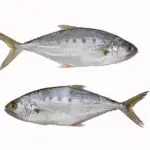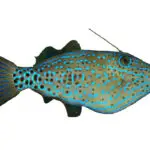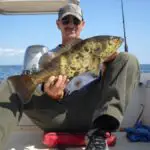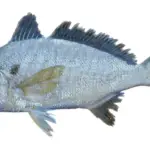If you’ve spent any time fishing or diving in the warm Atlantic waters of the eastern united states, you may have encountered a sheepshead.
But, did you know that this species of fish is commonly mistaken for other saltwater fish, even by experienced anglers?
So, what does a sheepshead fish look like?
In this article, ill tell you exactly what a sheepshead looks like, and talk about the distinguishable features.
I’ll answer a few commonly asked questions and provide some great photos too.
NOTE: This article is specifically about the saltwater sheepshead (Archosargus probatocephalus). If you are looking for information about freshwater drum (also nicknamed sheepshead) visit my article here.
Table of Contents
- What do Sheepshead Fish Look Like?
- What Do Sheepshead Fish Teeth Look Like?
- What Fish Look Similar to Sheepshead?
- Conclusion
- Related Posts
What do Sheepshead Fish Look Like?
The sheepshead fish has a deep oval-shaped silver body, with 5-7 vertical black stripes. The fins are short and dark in color, with notable spines on the dorsal area. Perhaps the most recognizable feature are its large, distinct teeth similar to that of a human’s, which they use to crush and grind their food.
Size
The average adult sheepshead measures between 12 and 20 inches long and weigh between three and ten pounds. They grow until around seven years of age, and females are generally larger than males.
The current all-tackle world record sheepshead weighed a staggering 21 lbs, 4 ounces. It was caught by Wayne Deselle in New Orleans, Lousiana on April 16th, 1982.
While sheepshead can be found all over the Atlantic Ocean and Gulf of Mexico, this is somewhat surprising, as the coast of Florida is known to contain the highest concentration of the species anywhere in the world.
Color & Patterns
The sheepshead is a silver colored fish that is striped with black vertical “bars” or “bands.” There are typically between five and seven of these distinctive bands, though this number may vary.
These dark markings will fade slightly with age, and are a key feature when identifying a sheepshead.

In some regions, they have been nicknamed the “convict fish,” as their pattern of dark stripes can bear a resemblance to that of a prisoner’s outfit.
They are also known as expert bait stealers!
When viewed in the light, they can also shine with a light green or yellow hue.
The outer skin of a sheepshead is very rough, which is ideal for the sharp and rocky habitat it prefers. Its scales are distinct and usually measure ⅛” in size.
Shape
When viewed from the side, the sheepshead has an oval-like shape that is flatter at the bottom and rounded at the top.
It has a dark spine-like fin running across the dorsal area, as well as smaller pointed anal fins. It has a semi-fork-shaped tail fin, as well as a moderately sized mouth relative to its large teeth.

Their faces are blunt and slightly rounded, with a flat noses and high forehead. Their lower jaw is smooth and does not contain any barbels. The spines of their fins are very sharp and can be more dangerous to anglers than their formidable set of teeth.
Locations
While sheepshead are most commonly located near the coast of Florida, they can be found up and down the entire East Coast of the United States.
Sheepshead Bay in New York City is named for the presence of these fish years ago, though they have generally fled due to pollution.
Sheepshead thrive in the Gulf of Mexico, and their habitat can extend all the way along with Central America and into the Caribbean. Sheepshead have also been caught as far south as Brazil, and as far north as Eastern Canada.
Behavior
Sheepsheads are omnivores and feed on everything from algae and barnacles to oysters and shrimp. This makes them extremely adaptable, as there isn’t much a sheepshead can’t eat.
They move closer to the coast in the spring to spawn, which they do multiple times per season.
Lifecycle
Sheepshead begin to spawn between February and April at the age of 2-4 years old. They move closer to the coast in the spring to spawn, which they do multiple times per season.
They are known to migrate inshore and offshore depending on the time of year and temperature.
When they are younger they stay near grass flats feeding on algae, and as they get older they move closer to piers, sea walls, jetties, and other structures.
Sheepshead can live for over 20 years!
What Do Sheepshead Fish Teeth Look Like?
The teeth of a sheepshead fish can look strikingly similar to those of a human at first sight, as their front rows are incisor-like and pointed at the end. Unlike predatory gamefish, sheepshead teeth are meant to grind and crush marine organisms such as barnacles, oysters and crabs.

The sheepshead’s diet consists heavily of crabs, shrimp, oysters, clams, and other hard-bodied creatures that require smashing and grinding of shells and exoskeletons.
They have an extra row of molars on the bottom of their mouth, and two extra rows on the top to assist with all of this grinding.
The teeth in the front of a sheepshead mouth are sharper, with the front row of teeth, in particular, most resembling a human’s.
These front teeth are used for prying clams, barnacles and other shellfish loose, as well as to crack them open. This is a unique combination of tooth shape and placement for a fish.
The sheepshead actually derives its name from these large, distinct teeth – as their smile can make them look like a sheep or horse when viewed from straight ahead.

While they may look intimidating at first glance, sheepshead are not dangerous in the water and are easily scared off.
Anglers should be careful when handling sheepshead and removing the hook, however, as putting a finger into their many rows of teeth can result in being bitten.
What Fish Look Similar to Sheepshead?
Black Drum, Atlantic Spadefish and Sergeant Major are all commonly mistaken for sheepshead, usually due to a similar dark striped pattern. However, there are a handful of key differences to look out for when trying to distinguish a sheepshead from one of these imposters.
Black Drum
The black drum is the most common fish to be mistaken for a sheepshead, as they have similar markings and are both commonly caught in the same habitat.

While they both have vertical black stripes, there are a few key differences that make the two easy to distinguish from one another.
First, the spiny dorsal fin of the sheepshead is one solid ridge, where the black drum has two separate dorsal fins on its back.
The black drum also has a rounded tail, where the sheepshead’s tail is forked. The black drum also has much smaller teeth than the sheepshead, as well as chin barbels.
Atlantic Spadefish
The Atlantic spadefish is another silver-colored fish with vertical black stripes that can be misidentified as the sheepshead. The spadefish has a much different body shape than a sheepshead or black drum, with a profile shaped more like an angelfish.

The spadefish also has a distinct rear-facing dorsal fin on the back half of its body, while the sheepshead’s solid spiny dorsal fin faces upward, and runs all the way along its back.
The spadefish’s teeth are also much smaller than the sheepshead’s, and the tops of their mouths have no teeth at all.
Sergeant Major
The sergeant-major is another saltwater fish found in the Atlantic Ocean and the Gulf of Mexico that is sometimes confused with a juvenile sheepshead.

While these fish are much smaller, only growing to about nine inches, they also have dark vertical stripes like that of a sheepshead.
While its stripes do bear a resemblance to a sheepshead’s markings, the sergeant major has a distinct yellow stripe running along the top of its body, as well as much smaller dorsal fins compared to a sheepshead.
They also have only a single row of teeth that are drastically smaller than a sheepshead’s.
Conclusion
By looking for a few simple attributes, such as the dark vertical stripes, flat human-like teeth, and large dorsal spines, you should have no problem spotting a sheepshead when you see it.
I hope the photos and descriptions in this article help you, especially the next time you are on the water fishing or enjoying the great outdoors.
See Also: Are Sheepshead Good To Eat? (Hint: Heck Yes They Are!)

Growing up in Florida, I’ve been surrounded by saltwater my entire life…and I love sharing my passion with others.
To learn more about why I started Saltwater Mecca, visit the ABOUT page.
Thank you for reading this article. Browse around & have some fun!





